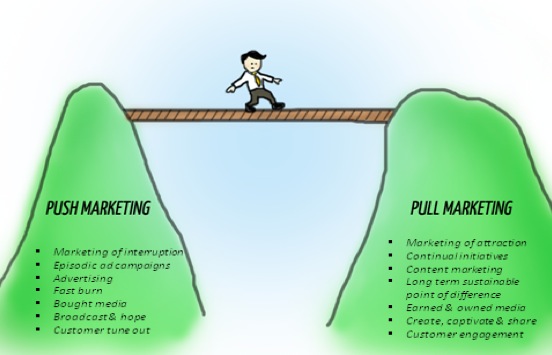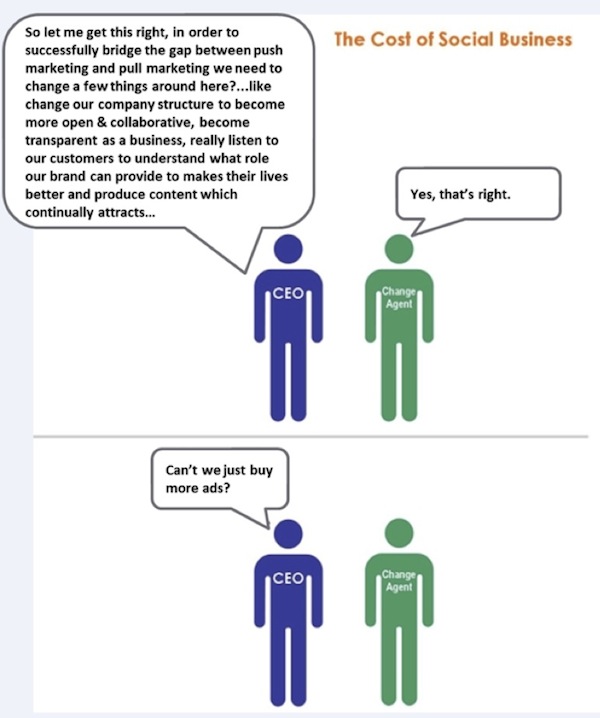Turning COI into ROI
Share
Recently, I looked at the issue of social-COI (cost of inaction) and now we turn our attention to making that first step towards the future and the fundamentals you’ll need to consider on the journey. We’ll see the emergence of a chief content officer and I’ll discuss their role and responsibility in the process.
Today, the whole concept of interruption marketing/advertising/media is massively patronising from a viewer/listener/reader perspective. Sure, once upon a time it was the price we paid for free or subsidised media, but not anymore. Advertising is ‘noise’ and consumers are increasingly able to tune it out and are equally empowered to get the media content they desire.
Renting time and space in editorial properties is not going to cut it anymore.
Even the most ardent luddites in business must accept the need to begin crossing the divide from push-interruption marketing to pull-attraction marketing. So do we continue to make ads and hope for the best or do we take stock of emerging trends and fundamentally have a rethink?
The chasm separating push from pull may look daunting but now is a great time to make the crossing. First, because it’s the smart thing to do and you’re likely to be one of the pioneers in your category to carve out a long term and sustainable competitive point of difference (sounds good?). And secondly, there will come a time when it will be too late to make the crossing because your business is struggling as competitors cross over ahead of you and outflank you (not so good).

There are six fundamentals you’ll need to take stock of in order to make the crossing:
- Company culture: shifting from silo-based departments to one of department integration, which can be an uncomfortable shift to make for many businesses. Businesses that make the crossing will enhance and improve their marketing initiatives, spend dollars more effectively and align to meet changing consumer expectations.
- Resources and staffing: new skills and new technologies will need to be embraced as marketing shifts to storytelling and content. New skills will emerge within marketing as publishers, producers and community managers.
- Budget: Facebook may be free, but nothing ‘just happens.’ Content initiatives will require a significant investment.
- Service provider relationships: these become more like partnerships, with collaborative openness and sharing.
- Tools vs strategy: the need to differentiate strategy from tools. Don’t lose sight of marketing fundamentals as you move towards the bright shiny objects in this space. The tools will come and go.
- Advertising integration: de-emphasise advertising and introduce content to become inter-related. In the next five years content marketing will permeate business so begin the process now. Every company will become a media company. Content builds stronger brands, awareness, trust, purchase intent, word of mouth, customer engagement, lower acquisition costs, reduced calls to the call centre, lower costs for search, lower costs for research etc.
So the challenge is how to get customers (B2C and B2B) tuning in to your brand. There will need to be new demands made of the marketing department and business as emerging technology allows any brand to function as a media company. Technology is now within everyone’s grasp enabling brands to go beyond ad campaigns and generate continual initiatives.
There are three categories of content marketing:
Entertainment, eg. http://www.youtube.com/watch?v=sjc5LFThDTQ
Information/education, eg. http://www.openforum.com/
Being helpful, eg. http://www.charmin.com/find-public-restrooms.aspx
and, all of the above, eg. IBM.
The rise of the chief content officer (CCO)
Content may live in marketing but stories and opportunities flow in from other departments whether it be from the customer coalface of sales and service, or working with partners, attending trade shows, conferences… any significant touchpoint, including, vitally, the CEO and key internal stakeholders.
Subject to the size of a company, the CCO will report to the head of marketing or the CEO and will emerge as a leader to oversee all marketing content initiatives to drive sales, engagement, retention, leads and positive customer behaviour. They are likely to come from a marketing and publishing mindset and be able to think like a publisher to lead the development of ‘customer first’ content initiatives to drive business.
The mark of a good CCO will be their ability to nurture, engage and retain customers, increase new prospects and reduce traditional overheads in the areas of customer service, search marketing, research and traditional media.
Where do you start producing great content?
Begin by listening and learning. You can’t know where you’re going until you know where you are. Conduct a content audit to determine current assets and their SEO potential.
Establish which key words your business needs to gather around. Who’s currently responsible for content (possibly a variety of departments). What’s missing? Could it be more topical, more entertaining? You’ll need an editorial calendar to keep focus, assign tasks and ensure the smooth flow of production. Can you repurpose and reuse existing content to reduce creative costs and maximise reach?
Companies who get it right will become leaders in their field. Through leadership, customers will turn to them for advice as trusted partners/spokespeople for their category.
In time all successful companies will make the crossing from push-interruption to the land of pull-attraction. As I write, some companies are standing around, doing nothing, with an air of curiosity and consideration while others are already across and monetising their content. The first of two great examples of this is Red Bull who are more focussed on their live events, their magazine and generally focussing on content over being a drinks company. The second example is of course our good friends at Blendtec who are monetising their content by selling DVDs of their series Will It Blend?… see an iPad blend here. You don’t need to be big to monetise content.
So where’s your head at? Do you want to mill around and wonder, or do you want to begin the crossing?
















